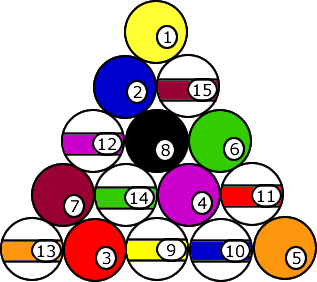4. LEARN TO PLAY 8-BALL (STANDARD POOL)
When people talk about playing pool, they're almost always talking about about 8-ball. The basic point is simple: you will either be the solid balls or the striped balls (your opponent will be the opposite). The goal is to get all of your own balls in and then sink the 8-ball before your opponent can do so. BUT, you can't sink the 8-ball until all of your own balls have been pocketed.
Keep in mind that there are tons of variations on the rules of 8-ball, but this version is basically correct and is best for beginners:
Racking
You use all 15 balls for 8-ball. Put the 8-ball in the middle and the 1-ball in front. For the rest, just alternate striped and solid balls throughout the remainder of the triangle (this won't work out perfectly, but do the best you can).

The rules
- Flip a coin to determine who's going to break.
- Let's say that you win the coin flip and get to break. Then go for it. Starting now, you and your opponent (let's call her "Monica") switch turns (each getting one turn) until someone sinks a ball.
- Whoever sinks a ball first becomes that type of ball (a solid or a stripe). So if you sink a ball first and it's a 14 (stripe), then you are stripes and Monica is the solids.
- If you pocket a ball on the break, then it still counts; you are the type of ball that you sank. HOWEVER, if you're not happy with the ball you pocketed on the break, you can "refuse" it and attempt to pocket the other type of ball. This can only occur on the break.
- If you happen to sink TWO balls on the break (or if Monica has yet to sink a ball and you're still trying to determine who is what), and one ball is a stripe and the other is a solid, then you get to pick which type you want to be.
- If you pocket a ball on the break, then it still counts; you are the type of ball that you sank. HOWEVER, if you're not happy with the ball you pocketed on the break, you can "refuse" it and attempt to pocket the other type of ball. This can only occur on the break.
- Whenever you (or Monica) sinks a ball, you get rewarded by getting another turn. This is always the case, whether you sink a ball on the break or later on.
- As we said earlier, the object is now for you to sink all your balls first while avoiding the 8-ball. Once you have pocketed ALL of your type of ball, you can then try to sink the 8-ball. If you sink the 8-ball at ANY point before your balls are cleared, you automatically lose the entire game.
- For the 8-ball (and only the 8-ball), once you get your chance to sink it, you must declare beforehand which pocket you are aiming for. If it goes into another pocket, you lose. If it goes in your pocket, you win! If you miss but it doesn't go into another pocket, Monica gets a turn and you don't get another turn until she misses a shot.
Scratching
Remember "scratching"? It means that you either hit the cue ball into a pocket, your opponent's ball into a pocket, or you didn't hit any balls at all. When you scratch, you automatically lose your turn. Here are some more specific details about each case:
- "I hit the cue ball into a pocket!" If you pocket an object ball and the cue ball on the same turn, the object ball is removed and placed back on the table (on the footspot), and the cue ball is placed anywhere on, next to, or behind the headspot, as decided by Monica.
- "I hit Monica's ball into a pocket!" If you pocket Monica's ball, your turn is over and her ball stays in the pocket. It's just bad luck for you that you happened to help her.
- "I didn't hit any balls!" If you hit the cue ball and it doesn't come into contact with any other ball, then you lose your turn unless it bounces off 3 walls of the table before coming to a stop. If you do scratch, then Monica can pick up the cue ball and move it on, next to, or behind the head spot.
- "I scratched, and all I have left is the 8-ball!" If you scratch in any way described above, and you only have the 8-ball left to sink, then you lose. We're terribly sorry. Because this can be incredibly frustrating, novices may want to eliminate this rule until they get better.

